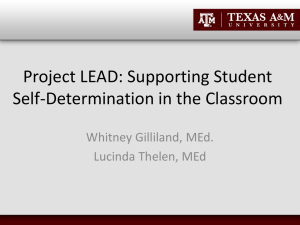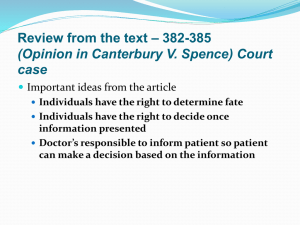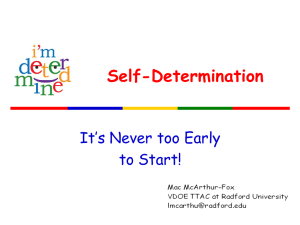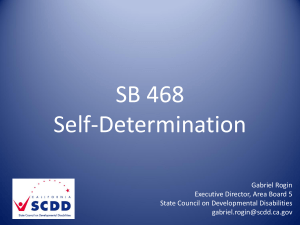SA14 Self-Determination and the Education of Students with Di
advertisement
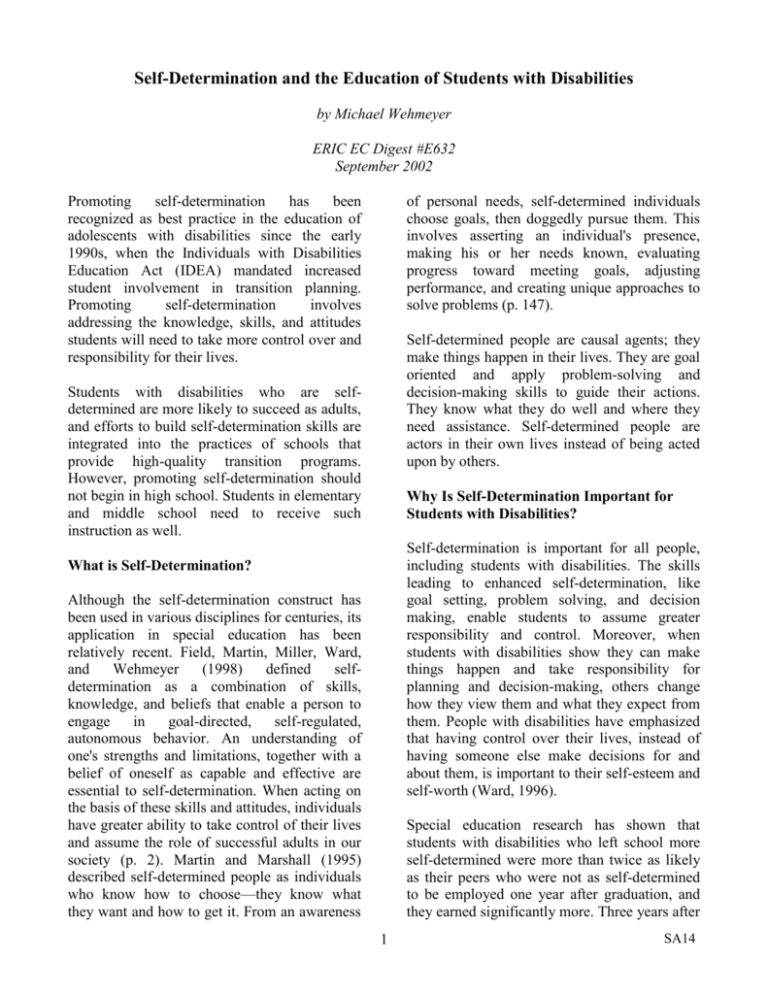
Self-Determination and the Education of Students with Disabilities by Michael Wehmeyer ERIC EC Digest #E632 September 2002 Promoting self-determination has been recognized as best practice in the education of adolescents with disabilities since the early 1990s, when the Individuals with Disabilities Education Act (IDEA) mandated increased student involvement in transition planning. Promoting self-determination involves addressing the knowledge, skills, and attitudes students will need to take more control over and responsibility for their lives. of personal needs, self-determined individuals choose goals, then doggedly pursue them. This involves asserting an individual's presence, making his or her needs known, evaluating progress toward meeting goals, adjusting performance, and creating unique approaches to solve problems (p. 147). Self-determined people are causal agents; they make things happen in their lives. They are goal oriented and apply problem-solving and decision-making skills to guide their actions. They know what they do well and where they need assistance. Self-determined people are actors in their own lives instead of being acted upon by others. Students with disabilities who are selfdetermined are more likely to succeed as adults, and efforts to build self-determination skills are integrated into the practices of schools that provide high-quality transition programs. However, promoting self-determination should not begin in high school. Students in elementary and middle school need to receive such instruction as well. Why Is Self-Determination Important for Students with Disabilities? Self-determination is important for all people, including students with disabilities. The skills leading to enhanced self-determination, like goal setting, problem solving, and decision making, enable students to assume greater responsibility and control. Moreover, when students with disabilities show they can make things happen and take responsibility for planning and decision-making, others change how they view them and what they expect from them. People with disabilities have emphasized that having control over their lives, instead of having someone else make decisions for and about them, is important to their self-esteem and self-worth (Ward, 1996). What is Self-Determination? Although the self-determination construct has been used in various disciplines for centuries, its application in special education has been relatively recent. Field, Martin, Miller, Ward, and Wehmeyer (1998) defined selfdetermination as a combination of skills, knowledge, and beliefs that enable a person to engage in goal-directed, self-regulated, autonomous behavior. An understanding of one's strengths and limitations, together with a belief of oneself as capable and effective are essential to self-determination. When acting on the basis of these skills and attitudes, individuals have greater ability to take control of their lives and assume the role of successful adults in our society (p. 2). Martin and Marshall (1995) described self-determined people as individuals who know how to choose—they know what they want and how to get it. From an awareness Special education research has shown that students with disabilities who left school more self-determined were more than twice as likely as their peers who were not as self-determined to be employed one year after graduation, and they earned significantly more. Three years after 1 SA14 graduation, they were more likely to have obtained jobs that provided benefits like health coverage and vacation and were more likely to be living somewhere other than the family home (Wehmeyer & Palmer, in press; Wehmeyer & Schwartz, 1997). What Can Educators do to Promote Student Self-Determination? The educational planning and decision-making process is an ideal situation in which to teach goal setting, problem solving and decision making for all students (Powers, et al., 1996; Wehmeyer, Agran, & Hughes, 1998). Instruction promoting components of selfdetermination should be infused throughout the curriculum. Doll, Sands, Wehmeyer, and Palmer (1996) identified age-appropriate activities addressing many of these components: Teach the skills and knowledge students need to become self-determined. The educational programs of all students should promote the skills needed to Use a problem-solving process to identify a problem, gather information, list and consider options, consider advantages and disadvantages, choose and implement a solution, and evaluate the effectiveness of the solution. Use a decision-making process to identify a situation that requires a decision, gather information, identify options, predict consequences, and take action to implement a decision (Texas Education Agency, 1997). Early Elementary Set personal goals Solve problems that act as barriers to achieving these goals Make appropriate choices based on personal preferences and interests Participate in decisions that impact the quality of their lives Advocate for themselves Create action plans to achieve goals Self-regulate and self-manage day-today actions These are not only independent living and selfmanagement skills, they also involve students with disabilities in the general curriculum as required by the IDEA. Most state and district standards include standards pertaining to goal setting, decision making, and problem solving. For example, the Texas Essential Knowledge and Skills (TEKS) 6th grade social studies standards require students to use problemsolving and decision-making skills and to work independently and with others in a variety of settings. Students are expected to Provide opportunities for students to make choices, teaching them that they can exert control and that most choices have limited options from which to select. Promote early problem-solving skills by encouraging students to think aloud as they address simple problems. Teachers should model their own problem-solving processes. Provide feedback regarding the outcomes of their choices to begin to teach students to link choices and consequences. Teach students to evaluate their work in comparison to a standard ("Does your paper look like this?") to lay the foundation for later self-management skills. Late Elementary and Middle School 2 Teach students to systematically analyze potential options with related benefits and disadvantages in order to participate in simple decisions, and to examine past decisions to determine if the consequences were anticipated or desired. Coach them in setting and committing to personal and academic goals, including identifying steps to achieve goals and obtaining support to monitor progress. Encourage them to evaluate task performance and reflect on ways to improve and enhance performance. Communicate high expectations and emphasize student strengths and uniqueness. One simple yet powerful activity that can promote student self-determination is to have high expectations for students and communicate those expectations to students often. Students with disabilities are often all too aware of what they cannot do, and they often are not as aware of their unique strengths and abilities. Junior High and High School Create a learning community that promotes active problem solving and choice opportunities. Encourage students to make decisions that affect their day-to-day activities, including academic goals, post-school outcomes, schedules, and others. Emphasize the link between goals that students set and the daily decisions and choices they make, and teach them to break long-term goals into short-term objectives. Students who learn to solve problems do so in classrooms that value diversity in opinion and expression and create a 'safe' place for students to provide answers that might be incorrect, knowing that they will be provided the support to learn from mistakes and, eventually, solve problems successfully. Such learning communities often emphasize collaborative efforts, including classroom rule setting, and enable students to make choices about when, where, and how they learn what they need to achieve (Sands, Kozleski, & French, 1999). Promote active involvement in educational planning and decision-making. The IDEA requires that from 14 years onward, transition needs and services be addressed on a student's IEP and goals related to these services be based on student needs, interests, and preferences. Transition planning provides a powerful context in which to both teach and practice skills like goal setting, problem solving, effective communication and listening skills, assertiveness and self-advocacy, and decisionmaking. Younger students (in elementary and middle school) should be involved in planning activities as well. Create partnerships with parents and students to ensure meaningful involvement. A focus on self-determination is not a license to exclude parents and family from decisionmaking and educational planning. While much can be done at school to promote selfdetermination, unless parallel activities occur at home, these efforts will not be sufficient. Parents are a student's first and longest lasting teachers, and it is important that from elementary school on, teachers work to ensure the meaningful involvement of parents, family, and students in educational planning and decision making. Teach students to direct their own learning. Research has shown conclusively that students with disabilities can learn and use strategies like self-instruction, self-monitoring, and selfevaluation, and antecedent cue regulation to learn academic content such as reading or math skills or to improve performance in such areas as vocational education and independent living skills. Teaching students to self-direct learning promotes self-determination and autonomy. References Doll, E., Sands, D., Wehmeyer, M. L., & Palmer, S. (1996). Promoting the development and acquisition of self3 determined behavior. In D. J. Sands & M. L. Wehmeyer (Eds.), Selfdetermination across the life span: Independence and choice for people with disabilities (pp. 65-90). Baltimore: Paul H. Brookes. Texas Education Agency, (1997). Texas Essential Knowledge and Skills. Austin, TX: Author. Ward, M.J. (1996). Coming of age in the age of self-determination: A historical and personal perspective. In D.J. Sands & M.L. Wehmeyer (Eds.), Selfdetermination across the life span: Independence and choice for people with disabilities (pp. 1-16). Baltimore: Paul H. Brookes. Field, S., Martin, J., Miller, R., Ward, M, & Wehmeyer, M. (1998). A practical guide for teaching self-determination. Reston, VA: Council for Exceptional Children. Martin, J. E., & Marshall, L. H. (1995). ChoiceMaker: A comprehensive selfdetermination transition program. Intervention in School and Clinic, 30, 147-156. Wehmeyer, M. L., Agran, M., & Hughes, C. (1998). Teaching self-determination to students with disabilities: Basic skills for successful transition. Baltimore: Paul H. Brookes. Powers, L., Wilson, R., Matuszewski, J., Phillips, A., Rein, C., Schumacher, D. & Gensert, J. (1996). Facilitating adolescent self-determination: What does it take? In D.J. Sands & M.L. Wehmeyer (Eds.), Self-determination across the life span: Independence and choice for people with disabilities (pp. 257-284). Baltimore: Paul H. Brookes. Wehmeyer, M.L., & Palmer, S. (in press). Adult outcomes for students with cognitive disabilities three years after high school: The impact of self-determination. Education and Training in Mental Retardation and Developmental Disabilities. Wehmeyer, M. L. & Schwartz, M. (1997). Selfdetermination and positive adult outcomes: A follow-up study of youth with mental retardation or learning disabilities. Exceptional Children, 63, 245-255. Sands, D.J., Kozleski, E., & French, N. (1999). Inclusive education in the 21st Century. Belmont, CA: Wadsworth. ERIC Digests are in the public domain and may be freely reproduced and disseminated, but please acknowledge your source. This publication was prepared with funding from the Office of Educational Research and Improvement (OERI), U.S. Department of Education, under contract no. ED-99-CO-0026. The opinions expressed in this report do not necessarily reflect the positions or policies of OERI or the Department of Education. The ERIC Clearinghouse on Disabilities and Gifted Education (ERIC EC), The Council for Exceptional Children, 1110 N. Glebe Rd., Arlington, VA 22201-5704, Toll Free: 1-800-328-0272, E-mail: ericec@cec.sped.org, Website: http://ericec.org. SA14 4
